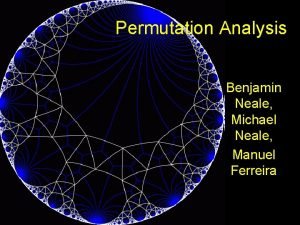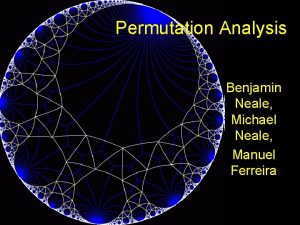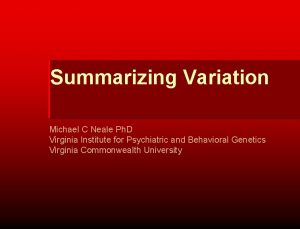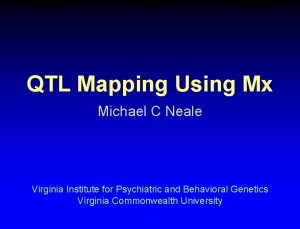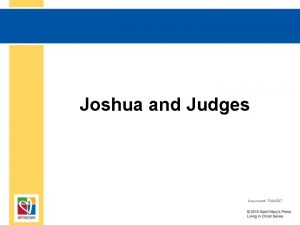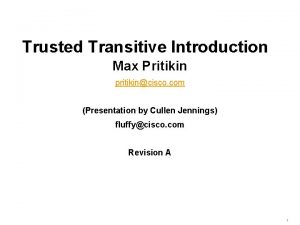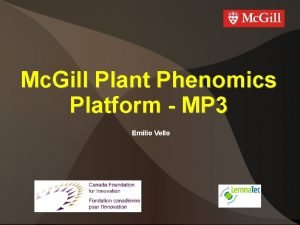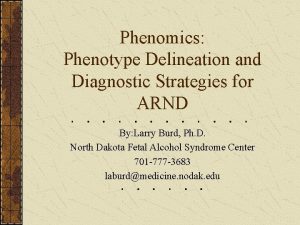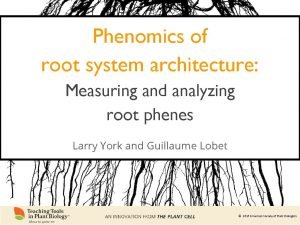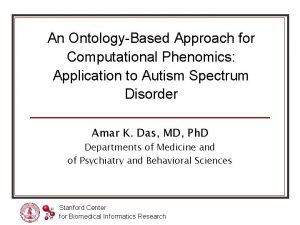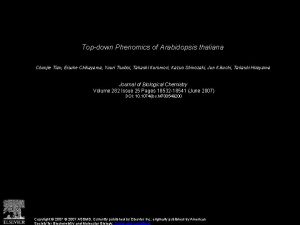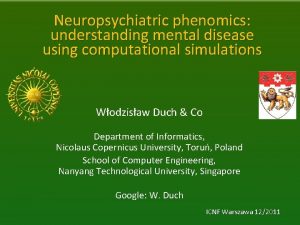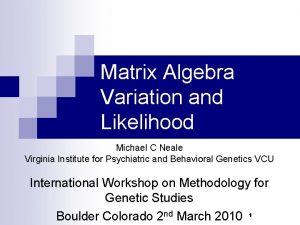Phenomics Michael Neale Joshua Pritikin Virginia Institute for



















































- Slides: 51

Phenomics Michael Neale & Joshua Pritikin Virginia Institute for Psychiatric & Behavioral Genetics Virginia Commonwealth University Boulder Workshop 8 March 2019

Outline Measuring Complex Traits Drug factors vs. Symptom factors Genomewide Structural Equation Modeling Testing Hypotheses about Gene Action: FTND Obligate Missingness Developmental Issues Future Directions including GREML

Measurement Invariance: Factor Model Usually want to know about F, the latent factor! Indirect measurement

Correlations across Substances: Add Health Stimulants Tranquilizers Marijuana Stimulants 1 Tranquilizers 0. 74 1 Marijuana 0. 63 0. 66 1 Factor Loadings 0. 84 0. 87 0. 75 Medland & Neale (2010) An integrated phenomic approach to multivariate allelic association. European Journal of Human Genetics 18: 233– 239

DRD 2 Association Results (Add Health) • Univariate associations • Stimulants: • Tranquilizers: • Marijuana: χ2=3. 88, β= -. 18, p <. 05 χ2=1. 65, β=. 13, NS χ2=2. 60, β=. 11, NS Stimulants Tranquilizers Marijuana • Factor level association • χ =0. 65, k. F=. 06, NS 2 • Item level association • χ =13. 91 (3 df; p < 0. 005) 2 –βStimulants = -0. 19 –βTranquilizers= 0. 14 –βMarijuana = 0. 11 60% 45% 30% 15% % A 1/A 1 A 1/A 2 A 2/A 2

MNI Causes Errors of Inference Sum Scores & Factor Scores Depend on Model Item-level Differences May: Invalidate Group Mean Tests (Association even) Invalidate Group Variance Tests MI Still Rarely Tested

Invariance: Five Potential Types of Difference Factor Variances Factor Means Factor Loadings Item Variances Item Means

Invariance Models of Factor. Level Effects 1. No Covariates 2. Age/Sex on 3. Age/Sex on 4. Age/Sex on Factor Mean Factor Variance Mean and Variance

MI Application: National Survey of Drug Use in Households (NSDUH) Substance Abuse and Mental Health Services Administration (SAMSA) regular data collection ~50, 000 persons per assessment Face-to-face Interviews(!) Audio-Computer-Assisted Testing

Map Items to DSM-IV Substance Abuse and Dependence Criteria A 1 During the past 12 months, did using marijuana or hashish cause you to have serious problems like this either at home, work, or school? A 2 During the past 12 months, did you regularly use marijuana or hashish and then do something where using marijuana or hashish might have put you in physical danger? A 3 During the past 12 months, did using marijuana or hashish cause you to do things that repeatedly got you in trouble with the law? A 4 Did you continue to use marijuana or hashish even though you thought it caused problems with family or friends?

DSM-IV Dependence Criteria D 1 During the past 12 months, did you need to use more marijuana or hashish than you used to in order to get the effect you wanted? D 3 Were you able to keep to the limits you set, or did you often use marijuana or hashish more than you intended to? D 4 During the past 12 months, did you want to or try to cut down or stop using marijuana or hashish? D 5 During the past 12 months, was there a month or more when you spent a lot of your time getting or using marijuana or hashish? D 6 This question is about important activities such as working, going to school, taking care of children, doing fun things such as hobbies and sports, and spending time with friends and family. During the past 12 months, did using marijuana or hashish cause you to give up or spend less time doing these types of important activities? D 7 Did you continue to use marijuana or hashish even though you thought it was causing you to have physical problems?

Test of Item Mean Invariance: Marijuana in NSDUH Strong evidence of MNI with respect to age and sex Examine individual items Four column heatmap for significance of effects Item Means & Factor Variances Sex and Age Compare across self-reported race

-2 ln. L Likelihood Ratio Test Statistics: Marijuana Item Means & Factor Loadings Entire Sample +/- sign denotes direction Sex Age Work Danger Law Friends Tol >Intend Try. Cut Time. Get Time. Other< Phys. Prob

Estimating Factor Scores f Factor Loadings Factor Score

ML Estimation of Factor Scores f Factor Score Likelihood of items conditional on factor score Factor *Loadings Items independent conditional on factor score: Means and variances change according to size of factor loadings

Alcohol Misclassified (overestimated) relative to target individual

Drug vs Symptom Factors DSM III-R/IV drug abuse and dependence symptoms for cannabis, sedatives, stimulants, cocaine, opioids and hallucinogens 13 misuse symptoms measured across six illicit substance categories (78 items) 4179 males born 1940– 1970 from the population-based Virginia Adult Twin Study of Psychiatric and Substance Use Disorders Confirmatory factor analyses tested specific hypotheses regarding the latent structure of substance misuse

Drug vs Symptom Factors Clark, S. L. , Gillespie, N. A. , Adkins, D. E. , Kendler, K. S. , and Neale, M. C. (2016). Psychometric modeling of abuse and dependence symptoms across six illicit substances indicates novel dimensions of misuse. Addict Behav, 53: 132– 40. PMCID: PMC 4679450.

Drug vs Symptom Factors Adding symptom factors dramatically improves fit Majority of variance in many Sx due to symptom not drug factor

Factor Score Notes Factor scores do not all have same error variance Factor scores of A, C & E components may correlate highly Latent trait may be non-normal (Schmitt et al 2006 Multiv Behav Res) Factor loadings (precision) may vary across the distribution and give spurious Gx. E results Variation may be discrete not continuous For PRS, consider trait as measured at GWAS

Mild Cognitive Impairment VETSA Data: CHD & AD PRS Ischemic heart disease: summary measure history of myocardial infarction, cardiac procedure or angina. Group N Cognitively Normal Amnestic MCI 1119 89 56. 7 (3. 3) 57. 2 (3. 5) APOE-ε 4+ 29. 4% 26. 2% Ischemic Heart Disease* Depressive symptoms, mean (SD) 13. 3% 3. 5% 7. 8 (7. 6) 9. 0 (8. 4) 10. 7% 11. 5% Age, mean (SD) Diabetes

Plots of the interaction of an Alzheimer’s disease polygenic risk score with A) a prevalent coronary artery disease polygenic risk score (CAD-PRS) and B) an incident CAD-PRS on amnestic mild cognitive impairment (MCI) status. The regression coefficient of the AD-PRS on amnestic MCI status is on the y-axis and is plotted across varying levels of CAD-PRSs on the x-axis. The dashed red line indicates the threshold of statistical significance for the ADPRS as a predictor of a. MCI status. In A the AD-PRS is more predictive of risk for a. MCI to the right of the dashed line (i. e. , people with higher AD-PRSs are more likely to have a. MCI if they also have higher incident CAD--RSs). In B the AD-PRS is a significant predictor of increased risk for a. MCI to the left of the dashed line but is not significant to the right of the dashed line.

Item Response Probability Example item response probability shown in white Possible population distribution in green f(x) normal pdf Response Probability Cumulative N 0. 4 1 0. 3 . 75 0. 2 . 5 0. 1 . 25. 0 -4 -3 -2 -1 0 z-score 1 2 3 4

AFQT 100 Items Subscales 1 Arithmetic Reasoning 2 Mathematics Knowledge 3 Word Knowledge 4 Paragraph Comprehension Script & Fake Data are in workshop/faculty/mcn/2019

AFQT: Overall Test Information Curve More information at left By design Consequences for Gx. E?

Genome-wide SEM Avoid problems with factor scores Fit factor or growth curve models to ordinal data Include effect of SNP on factor or items Repeat for the other 8 m-1 SNPs Manhattan plot results http: //goo. gl/f 44 Um. D Verhulst, B, Maes, H, & Neale, M (2017) GW-SEM: A Statistical Package to Conduct Genome-Wide Structural Equation Modeling. Behav Genet 47(3): 345 -359

Testing Hypotheses about Gene Action: FTND rs 16969968 Neuronal acetylcholine receptor subunit α-5 CHRNA 5 associated with both ND and CPD What is the mechanism of action? CPD mere symptom of FTND Increases CPD increases addiction? Feedback loop between CPD and addiction?

H 1 a SNP Causes Factor Only rs 16969968 CHRNA 5

H 1 b SNP Causes CPD Only

H 1 c SNP Causes Factor & CPD

H 2 a CPD Only & CPD causes Factor

H 2 b SNP to CPD & Reciprocal Factor

Two Factor Model

Model-Fitting Results: Bidirectionality > mx. Compare(Bidirectional. Fit, Two. Fit 1 a) base comparison ep minus 2 LL df AIC diff. LL diffdf p 1 Full. Rev <NA> 44 41709. 37 32194 -22678. 63 NA NA NA 2 Full. Rev Full 40 41730. 04 32198 -22665. 96 20. 67327 4 0. 0003675709

Factor Model Alternative: Mutualism Identified with data from relatives MZ & DZ Twins or adoptees needed for A/C resolution

What if Variation is Discrete? Latent Class and Latent Profile Models Factor Mixture Models Latent Growth Curve Mixture Models Regime Switching

Mixture Distributions Pearson, K. (1894). Contributions to the mathematical theory of evolu Skewness in a set of measurements of the ratio of forehead to body length of crabs Two species or one?

Latent Class (Subgroup) Model Class 1 probabilit yp Text Conditionally Independent ? ! Class 2 probabilit y (1 -p) Expensive!

Factor Mixture Model Class 1 probabilit yp Class 2 probabilit y (1 -p) Text Very Expensive!

Growth Curve Mixture Model Class 1 probabilit yp Class 2 probabilit y (1 -p) Text

Regime Switching Model Text

Obligate Missingness Estimating correlation between Stem and Probe 3+ categories of Stem and at least 2 lead to probe 2 binary Stem items and endorsing either or both = probe Binary Stem but collected from relatives who correlate < 1 Do not mark missing probes as zero! Usually causes inflated item correlations

Obligate Missingness Stem: Have you ever used cocaine? 0/1/2 Probe: Was it difficult to cut down or quit? Probe items are MAR conditional on Stem being 1 or 2 WLS but not ML drastically attenuate correlation estimate Must code probes as missing!

Genetic Correlations Vary with Age 8 -18 yrs, Giedd Study N~700


Genetic Heterogeneity with Age/Cohort Neuroticism within-person. 6 correlation over 10 years Twin studies show r. G < 1 over time Expressed genetic factors change during development Substance Use

Different age, different genes?

Age-Related Decay of Correlation Verhulst, B. , Eaves, L. J. , and Neale, M. C. (Jul 2014). Moderating the covariance between family member’s substance use behavior. Behav Genet, 44(4): 337– 46. Cov = Acov * *αa -|Δage| e + Ccov * *αc -|Δage| e + Tcov

Application Virginia 30, 000 Data on Smoking Twins, their parents, spouses, sibs and children Twins only here, N=14, 763 Crude smoking measure (1980 s) (1) never smoked, (2) used to smoke but gave it up, (3) smoked on and off, (4) smoked most of his/her life. Strong evidence of decay with age difference

Future Directions Use Genetic relatedness matrices GRMs in place of close family relatives Technical challenges, invert 20 k x 20 k matrices or larger Extend GW-SEM Extend tests for direction of causation with combined twin family, multivariate and repeated measures data Dynamical models for high density repeated measures

Acknowledgements • VIPBG NIDA R 01 DA-18673 • Brad Verhulst NIDA R 25 DA-26119 • Shaunna Clarke NIMH R 25 MH-19918 • Hermine Maes Study participants • Steve Aggen Workshop participants • Joshua Pritikin Open. Mx Team • Computers
 John neale elizabeth i
John neale elizabeth i Neale donald walsch pensées quotidiennes
Neale donald walsch pensées quotidiennes Zora neale hurston mother
Zora neale hurston mother Zora neale hurston
Zora neale hurston Northern virginia seo
Northern virginia seo Walkability
Walkability Tobinskatten för och nackdelar
Tobinskatten för och nackdelar Referatmarkeringar
Referatmarkeringar Kraftledning karttecken
Kraftledning karttecken Mjälthilus
Mjälthilus Varför kallas perioden 1918-1939 för mellankrigstiden?
Varför kallas perioden 1918-1939 för mellankrigstiden? Verifikationsplan
Verifikationsplan Rbk-mätning
Rbk-mätning Arkimedes princip formel
Arkimedes princip formel Förklara densitet för barn
Förklara densitet för barn Elektronik för barn
Elektronik för barn Borra hål för knoppar
Borra hål för knoppar Tack för att ni har lyssnat
Tack för att ni har lyssnat A gastrica
A gastrica Smärtskolan kunskap för livet
Smärtskolan kunskap för livet Bris för vuxna
Bris för vuxna Typiska novell drag
Typiska novell drag Trög för kemist
Trög för kemist Vad är ett minoritetsspråk
Vad är ett minoritetsspråk Indikation för kejsarsnitt på moderns önskan
Indikation för kejsarsnitt på moderns önskan Vilka tal pekar pilarna på
Vilka tal pekar pilarna på För och nackdelar med firo
För och nackdelar med firo Toppslätskivling dos
Toppslätskivling dos Redogör för vad psykologi är
Redogör för vad psykologi är Geometriska former i förskolan
Geometriska former i förskolan En lathund för arbete med kontinuitetshantering
En lathund för arbete med kontinuitetshantering Mat för unga idrottare
Mat för unga idrottare Etik och ledarskap etisk kod för chefer
Etik och ledarskap etisk kod för chefer Svenskt ramverk för digital samverkan
Svenskt ramverk för digital samverkan Datorkunskap för nybörjare
Datorkunskap för nybörjare Kvinnlig mantel i antikens rom
Kvinnlig mantel i antikens rom Orubbliga rättigheter
Orubbliga rättigheter Rita perspektiv
Rita perspektiv Ministerstyre för och nackdelar
Ministerstyre för och nackdelar Plats för toran ark
Plats för toran ark Nationell inriktning för artificiell intelligens
Nationell inriktning för artificiell intelligens Bästa kameran för astrofoto
Bästa kameran för astrofoto Sju principer för tillitsbaserad styrning
Sju principer för tillitsbaserad styrning Nyckelkompetenser för livslångt lärande
Nyckelkompetenser för livslångt lärande Romarriket tidslinje
Romarriket tidslinje Cirkelkomposition exempel
Cirkelkomposition exempel Gibbs reflekterande cykel
Gibbs reflekterande cykel Matematisk modellering eksempel
Matematisk modellering eksempel Verktyg för automatisering av utbetalningar
Verktyg för automatisering av utbetalningar Shaktismen
Shaktismen Bamse för de yngsta
Bamse för de yngsta Särskild löneskatt för pensionskostnader
Särskild löneskatt för pensionskostnader




















































